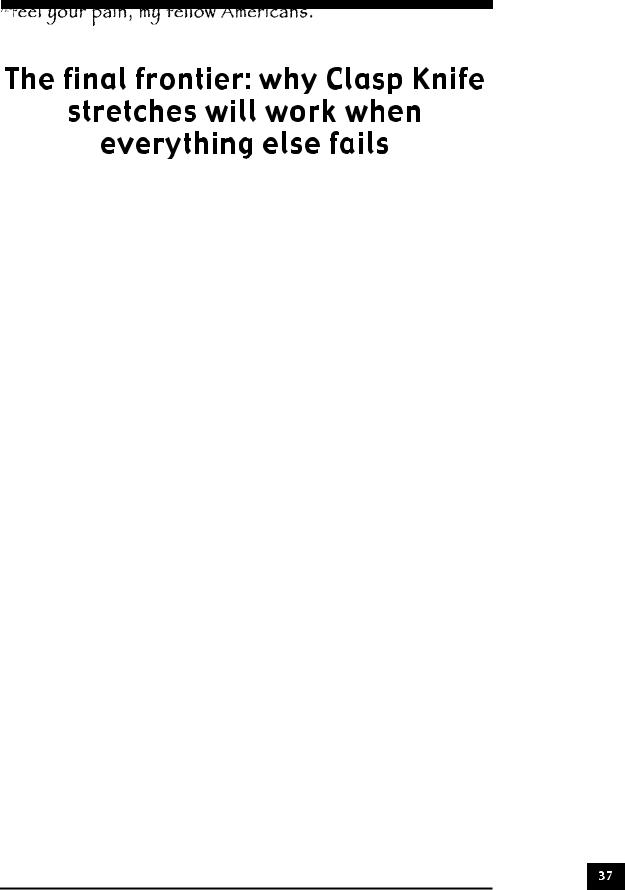
Растяжка расслаблением. П.Цацулин. Англ
.pdf
The effectiveness of conventional PNF can be dramatically increased through proper breathing. Take a lesson from Chi Kung, Tai Chi and Yoga. Masters of these Oriental disciplines put heavy emphasis on breathing exercises that leads to remarkable mastery of the body and mind. Here is why.
Your nervous system is subdivided into voluntary, which is in charge of things like lifting your arm or chewing your cheeseburger, and autonomic, which quietly runs things that are none of your business, like digesting that cheeseburger.
Breathing is the only function you can control both consciously and unconsciously because it is regulated by both branches of the nervous system through two independent sets of nerves. By controlling your breathing, you can control some of your body’s functions that were never meant to be controlled voluntarily, like your heart rate.
Note how forcing yourself to ‘take a deep breath’ when you freak out helps to calm you down. Because deep, relaxed breathing is incompatible with a stressed out mind, your body adjusts its physiology to your breathing via a feedback loop! Quoting Harvard M. D. and alternative medicine guru Andrew Weil, "Breathing is the bridge between mind and body, the connection between consciousness and unconsciousness."
Here is how you can breathe your way to greater flexibility. Get in the position of a comfortable stretch, placing some weight on the muscles you are stretching.
Inhale maximally and tighten up your entire body, especially the target muscles.
The deepest relaxation can only be achieved in contrast to great tension—the yin and yang of stretching, so to say. Or, if you prefer the Marxist terminology, ‘the unity and antagonism of the polarities’.
Think of your body as a fist. Literally making a fist will help. Pay attention not to decrease the amount of stretch when you are tightening up!
Hold your breath—and tension—for a second or so, then suddenly let it all out with a sigh of relief. Let your jaw and shoulders go limp with the rest of your body. Let your fists and face play dead. Turn your whole body into what Soviet psychologist Dr. Vladimir Levi called ‘a mentally relaxed fist’.

Visualize transforming from a tight spring into a limp noodle in a blink of an eye. A burst balloon is another useful analogy. Or try this vivid description of the tension/release sequence by Dr. Judd Biasiotto:
"You must relax instantly. To better illustrate what it would feel like to "turn off" as you have been instructed, picture yourself exerting all your strength in an effort to push a large boulder off a sheer cliff. When suddenly the boulder goes over the edge, there is no active resistance to your pushing and all your straining suddenly ceases. It is that feeling, that nothingness after the boulder drops, that you are striving to obtain when you "turn off your source of power."
At this point the stretch will increase, as the involved body parts will drop down when the tension is released. To make your stretches safer, don’t let the body parts drop more than an inch or so at a time. Keep repeating the drill until you can no longer increase your range of motion.
Because you are taking deep breaths, you are apt to hyperventilate. Don’t. In addition to making you dizzy, washing too much carbon dioxide out of your system, by breathing too much, will excite your nervous system. While powerlifters like to take advantage of this phenomenon when psyching up for a heavy attempt, it will make it harder for you to relax. A simple way to handle the problem is to postpone the inhalation by a couple of seconds following each exhalation: hold your ‘no-breath’.
Contrast Breathing is by far the easiest and least uncomfortable variation of contract-relax stretching. Obviously, if it gets you to your goals, Contrast Breathing is the approach of choice. If not—read on!



Although the primitive standard PNF protocol does improve flexibility better than conventional relaxed stretching—and builds some strength in the process— there are tricks of the trade that turn the contract-relax approach into a thermonuclear stretching weapon!
Take ‘Forced Relaxation’, an oxymoronic technique which should have been invented by the Russian military. Get into the stretch, then contract the specified muscles with one to two thirds of your maximum effort. Hold steady, unwavering tension—it is extremely important! If you were holding a real weight with the target muscle, the weight would stay put rather than bob up and down.
Don’t hold your breath. Breathe, but breathe shallow. Deep breathing will wave the tension in the stretched muscle up and down with every breath, something we are trying to avoid.
Hold the tension until it becomes unbearable, then release it with a sigh of relief—don’t let the breath get ‘caught’ in your chest, as is common for a very stressed out person, let go! —and immediately increase the stretch.
If you have the mental fortitude, keep the tension until your muscles start quivering and finally collapse in exhaustion, unable to contract any longer! This is the essence of Forced Relaxation. Aptly named, isn’t it? As we used to say in the Soviet Special Forces, "If you don’t know how—we’ll teach you, if you don’t want to—we’ll make you."
How long will you have to hold? It is hard to tell. Fifteen seconds, thirty seconds, a minute, even more. It depends on a whole lot of variables: the intensity of the contraction, your pain tolerance, and the muscle fiber type.
Drs. Verkhoshansky and Siff point out in Supertraining that "…prolonged muscle contraction would tend to be more easily maintained in slow postural (tonic) than in fast (phasic) muscles. Consequently, stretching procedures would have to be applied for longer periods on slow muscles to significantly enhance their flexibility."
No, you do not need a biopsy to determine the fast/slow fiber composition of your various muscles. Trial and error will do. Over a period of time you will find your sweet spot. For instance, you may observe that your hamstrings relax just fine after ten second contractions—while your hip flexors need a solid minute of tension before they are forced into exhaustion.


A kickboxer who had practiced mainstream PNF diligently for years came to me as the last resort. He was only three inches off the ground in the side split, yet never got any deeper. 'Experts' had told him it was not meant to be, he was not built for splits and too old. With the variation of isometric stretching described in this chapter, I put him in a full Russian split in ten minutes, screams notwithstanding.
This powerful variation of isometric stretching, ‘the Clasp Knife’ method, does not bother tricking the stretch reflex; it aggressively cancels it out!
The Clasp Knife takes advantage of nasty muscle software called the inverse stretch reflex. It does not take an Einstein to figure out that if the stretch reflex makes the muscles contract, its counterpart makes them relax. You have run across the inverse stretch reflex’s dirty work when you got whipped in arm wrestling. One moment your biceps is super tense—the next it turns to jello. Some neuroscientists and physical therapists liken this process to a jackknife’s blade suddenly giving way—hence ‘Clasp Knife’ stretching.
Where Forced Relaxation exhausted your muscles into submission, the Clasp Knife takes them by storm.
The inverse stretch reflex is the last line of defense against injuries. It takes over where the stretch reflex leaves off. As the muscle is fighting an overwhelming force it gets very tense. The tension sensors—the III and IV afferent free nerve endings and the Golgi tendon organs—send a ‘Relax!’ command to their muscle, to prevent it from ripping its tendons off their attachments.
Now, stop mumbling, "Is it safe, is it safe?" You sound like the Nazi dentist from The Marathon Man. The good news is that the shutdown threshold is set up very conservatively. Much more force is needed for the tissue to rupture than it takes to make your biceps give out; a tendon is usually two to three times stronger than its muscle!

Although it feels weird and scary—your overpowered muscles start shaking and finally give out against overwhelming resistance—the inverse stretch reflex overrides the stretch reflex and promotes a very deep relaxation of the tortured muscle.
What you get is a mega-stretching tool—for those with the heart to handle it.
The Clasp Knife—or ‘shutdown threshold isometrics’as it was referred to it in my earlier book—trigger the inverse stretch reflex to relax a muscle so you can then stretch it. The half-hearted contractions practiced by most physical therapists are way too wimpy to trigger the clasp knife effect.
Eastern European experts state that the Golgi tendon organs with the highest threshold cause the greatest relaxation. That means muscle tension must be extremely high. You must put weight on the stretched muscles and contract them to the hilt. It is very painful—scream your heart out!
East German specialists Drs. J. Hartmann and H. Tunnemann recommended seven second long powerful contractions alternated with six second relaxations when one aims to set off the Golgi tendon reflex. Russian scientist Dr. Leonid Matveyev advises five to six second long contractions and emphasizes that tension should increase gradually and reach its peak by the third or fourth second. A rapid buildup of tension in a stretch may result in an injury.
"Have the strength to force the moment to its crisis." These words by Thomas Stearns Eliot could be the motto of this super stretching technique.

I repeat, stretching the ligaments is unnecessary even for the performance of the most advanced gymnastic or martial arts skills! Your muscles have plenty of length to allow you to do splits, you just have to learn how to relax them.
You can accomplish the splits—even the suspended wishbone—by reeducating the nervous system. But some Yoga asanas—the goraksha asana, the sakthi chalini, the khanda peeda asana, the gomukhasana to name a few—can only be performed by
stretching the ligaments. The same goes for some popular Western stretches, including the notorious hurdler’s stretch. Stay the hell away from them! They offer no athletic benefits whatsoever—at least not for our species.
Ligaments hold your joints together. They do not stretch well, except in children. Stretch a ligament by only six percent and it will tear. Even if you manage to stretch it without ripping it,  do not consider yourself lucky. A
do not consider yourself lucky. A
ligament that has been subjected to excessive stretching undergoes microtears, gets scarred up, elongated, and weakened: a so-called plastic deformity. A stretched ligament means a loose and unstable joint just waiting for a severe injury. Or osteoarthritis; joint hypermobility leads to degenerative changes in the cartilage padding the joint.

How can you tell if you are stretching a ligament?
If you feel discomfort or pain in the joint, you are probably doing it. For example, your hamstrings meet their tendons a few inches above your knees. If you feel a pull in the back of your knee during a hamstring stretch, obviously you are loading the ligaments and joint capsules rather than stretching your hammies. The solution is to bend the knee slightly to unload the ligaments and refocus the stretch on the area between your glutes and a hand’s width above your knees.
The normal sensations during proper flexibility training are muscle tension— which may be painful.
